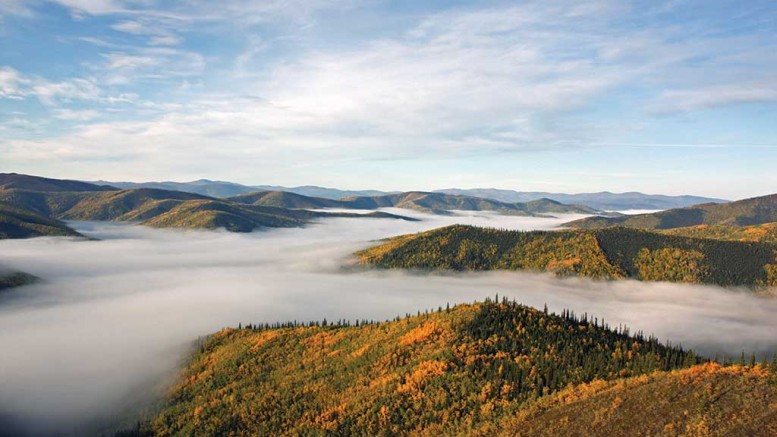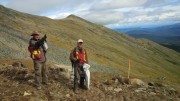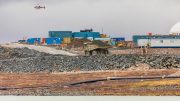With four discoveries in the Yukon last year, a property purchase this year, and financial and technical backing from partners Agnico Eagle Mines (TSX: AEM; NYSE: AEM) and Kinross Gold (TSX: K; NYSE: KGC), White Gold (TSXV: WGO) has momentum as it heads into 2019’s exploration season.
The company’s acquisition in January of the 163 sq. km QV project from Comstock Metals (TSXV: CSL) brings its holdings in the White Gold district to 4,390 sq. km — or, by its estimates, over 40% of the entire district.
The QV project comes replete with 230,000 contained oz. gold in 4.4 million inferred tonnes grading 1.65 grams gold per tonne — based on just 17 drill holes — and sits 44 km northwest of Goldcorp’s (TSX: G; NYSE: GG) Coffee project, which is being developed as an open pit and heap-leach gold mine, slated for production in 2021.
The project is 20 km southwest of the Vertigo discovery White Gold made in 2018, and contiguous to the company’s flagship White Gold property, which hosts the Golden Saddle and Arc deposits, 85 km south of Dawson City and 350 km northwest of Whitehorse.
Golden Saddle and Arc combined have 12.3 million indicated tonnes grading 2.43 grams gold for 961,000 contained oz. gold, and 4.9 million inferred tonnes grading 1.62 grams gold for 283,000 contained oz. gold. In addition to the mineral resource near surface, the deposits contain 235,000 inferred tonnes grading 3.53 grams gold that could be amenable to underground mining.
Jodie Gibson, White Gold’s vice-president of exploration, who works closely with renowned prospector Shawn Ryan, the company’s chief technical advisor, says the newly acquired QV project has similarities with the company’s existing deposits on the White Gold property. “The mineralization itself is as close as you could get to a twin of Golden Saddle,” he says in an interview. “The gold is great, metallurgically. It’s free milling — whether it’s oxide or sulphide — so that’s very attractive to us, as well, and it’s wide open both along strike and at depth, so we see potential to expand that resource.

Prospector Shawn Ryan examining a rock at the White Gold property in the Yukon in 2009. Photo by The Northern Miner.
“The 2014 resource for VG was based on fairly coarse and limited drilling — just 17 holes for just over 4,000 metres,” he adds. “So the fact that you’re getting a 230,000 oz. gold resource out of that is pretty impressive, as it is.”
Gibson — who was project manager on the QV project when Comstock Metals held the asset and oversaw the discovery holes in 2012 — notes that there are other targets on the large land package, such as Golden Saddle and Vertigo, which are each 12 km from the QV project, and that “we’re seeing similarities in terms of associated structural controls and geochemistry on some of the other targets on the QV property, and these are things I’ve seen with only limited work — mainly soil sampling and a bit of prospecting.”
White Gold has earmarked $13 million for the 2019 exploration season, which will include drilling at the VG deposit to expand the known resources, and regional exploration to advance high-priority targets in the area. The funds will also help the company’s four discoveries in 2018: Vertigo, GS West, Ryan’s Surprise and Betty Ford.
Vertigo will absorb the largest part of the budget — just over half, Gibson says — with 7,500 metres of diamond drilling across the 2 km trend to show the geology, geometry and continuity of the system, and another 2,500 metres for follow-up drilling on key zones within the system to test plunge lines and alternative geometries. A reverse-circulation drill will also test the continuity of mineralization along strike to build more targets for diamond drilling.

White Gold staff moves a GT Probe across the company’s White Gold district in Yukon. Credit: White Gold.
White Gold found Vertigo on its 570 sq. km JP Ross property in September 2018. Vertigo is 25 km north of Golden Saddle, 75 km south of Dawson City and within 2 km of an existing road. Highlights from drilling include hole 18-14 and hole 13, which intersected 23.44 grams gold per tonne over 30 metres from surface, and ended in mineralization. Hole 18-1 cut 56.25 grams gold over 3 metres within a broader intercept of 17.34 grams gold over 11 metres, from 3 metres’ depth.
At least 12 individual mineralized structures have been found over a 1,500- by 650-metre area, with 14 known target areas. Drill testing to date has validated mineralization over 500 metres of strike length, which is open along strike and at depth, along a 12 km mineralized trend.
“The key takeaways with Vertigo are: a) it has got a very large footprint, of which we have only drilled a fraction; b) it’s high grade; c) all indications from the field and from studies we have done since then is that the gold is coarse and free milling; and d) it’s road accessible,” Gibson says.
“It’s the first kind of evidence that we have within the Klondike of gold in the rock, and you can follow it down to the point where they are actively mining placer gold in the creek,” he continues. “When you think of high-grade things, some people think of veins or vertical structures, and what’s unique about Vertigo is that we have identified multiple structures — about a dozen — within a 650-metre corridor. From drilling last year, we tested them over 300 metres of strike length, but we know from our soils, prospecting and geophysics that the trend extends upwards of 2 km, and so, for this reason, we’re going to have two diamond drills and a 10,000-metre program focused on defining the geometry of these zones, looking at continuity laterally and vertically, and testing these things to depth.”
So far Vertigo has only been tested 100 metres deep.
White Gold also plans to drill its recent GS West and Ryan’s Surprise discoveries.
The company found the GS West zone in September 2018, 750 metres west of the edge of the Golden Saddle deposit. The new shallow mineralized zone is open at depth and along strike, and intersected mineralization in all three holes, including 1.92 grams gold over 24 metres from 117 metres’ depth in hole 18-DO184, with 2.97 grams gold over 10 metres from 118 metres’ depth.
The discovery, White Gold says, shows the potential for more zones of near-surface mineralization close to Golden Saddle.

White Gold’s JP Ross gold exploration property, which hosts the Vertigo discovery. Credit: White Gold.
GS West, Gibson says, has the same mineralized structure and mineralization as Golden Saddle. “The mineralization was just beyond 100 metres below surface, so it’s potentially open-pittable and checks all the boxes, with us being able to expand the Golden Saddle resource. This year we’ll have about 5,000 metres of diamond drilling focused on the GS West area and connecting the dots between it and Golden Saddle itself, and building that resource.” In addition, 1,500 metres of infill and step-out drilling is planned for the Arc deposit.
White Gold expects to drill between 1,000 and 1,500 metres this year to follow up on its discovery in August of Ryan’s Surprise, which is 2 km west of GS West. The discovery was situated on an 800- by 115-metre soil anomaly, with values from trace up to 1.6 grams gold per tonne, on trend with Golden Saddle. The discovery hole intersected 20.64 grams gold over 6 metres from 84 metres’ depth in hole 18RC1. Drill hole 18RC2 returned 13 metres of 5.02 grams gold from 122 metres downhole, including 9.25 grams gold over 5 metres from 123 metres downhole, 100 metres west of the discovery hole.
Ryan’s Surprise “is a different structural system, but the unique thing about it is that it’s very high grade, and has some similarities with Vertigo,” Gibson says. “We’re looking at near-vertical, high-grade structures.”
It also found a zone in October called Betty Ford in the centre of its Betty property, 58 km southwest of Golden Saddle and 62 km south–southwest of Vertigo, along the continuation of the Coffee Creek fault. The property is contiguous to Goldcorp’s Coffee and Western Copper and Gold’s (TSX: WRN; NYSE-AM: WRN) Casino properties to the east.

Rotary air-blast drillers at White Gold’s Betty gold project in the Yukon. Credit: White Gold.
The Betty property consists of a 12 km trend of anomalous gold in soils associated with intrusion-related and structurally controlled-style gold targets. Drilling on the Ford target consisted of 504 metres of shallow (less than 100 metres’ depth) rotary air-blast drilling over six holes covering a 220- by 160-metre area within the central part of the soil anomaly.
Hole 18-2 cut 1.08 grams gold over 50 metres from 5 metres’ depth, including 2.24 grams gold over 9 metres from 20 metres downhole, with the top 26 metres of the hole showing oxidized mineralization. Hole 18-1 intersected 4.59 grams gold over 2 metres within a broader 24-metre intercept grading 0.94 gram, starting from 20 metres deep.
“The Betty property remains underexplored, and we believe that this preliminary shallow drill program has just scratched the surface of the mineral potential along the Coffee Creek fault,” Gibson says. “This one we definitely need to follow up on.”
Unlike the Coffee deposit, which has strong arsenic association, Gibson says, the Ford is gold only, and it’s more akin to the Golden Saddle deposit. “We have got some ideas on structural controls and orientation, but we have the luxury of time with this, so we’ll go in and do some detailed geological mapping and interpretation, and then set up our next steps.”
White Gold CEO David D’Onofrio is excited about the company’s prospects.
“What I love is we’re seeing that our thesis is playing out,” he says. “We’re having success, and the more success we have the more we learn, and the more confident we’re becoming in the probability of future discoveries.
“We have a lot going on. This company is set up for the next 30 years, and we’re just scratching the surface now. What we have is akin to owning 40% of the Timmins camp 40 or 50 years ago.”
At press time, White Gold shares traded at $1.16 in a 52-week range of 54¢ to $2. White Gold has a $133-million market capitalization.
Agnico Eagle Mines and Kinross Gold each own 19.2% of the company. Management and insiders own 23%, with the other 38.6% public float including several strategic institutional shareholders.





Finding a lot of gold is nice but i would like to see a timetable for leasing this discovery to someone who will actually pour some gold.